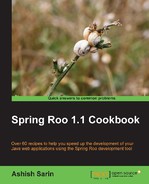Spring Roo is an easy-to-use productivity tool for rapidly developing Java enterprise applications using well-recognized frameworks such as Spring, Hibernate, AspectJ, Spring Web Flow, Spring Security, GWT, and so on. Spring Roo takes care of creating Maven-enabled projects, enterprise application architecture based on your choice of technologies, unit and / or integration tests based on your choice of testing framework, and so on. The bottom line is that if you're using Spring, then you should consider using Spring Roo for increased productivity
Spring Roo 1.1 Cookbook brings together a collection of recipes that demonstrate how the Spring Roo developer tool simplifies rapidly developing enterprise applications using standard technologies and / or frameworks such as JPA, GWT, Spring, Flex, Spring Web Flow, Spring Security, and so on. It introduces readers to developing enterprise applications for the real world using Spring Roo tool. The book starts off with basic recipes to make readers comfortable with using Spring Roo tool. As the book progresses, readers are introduced to more sophisticated features supported by Spring Roo in the context of a Flight Booking application. In a step-by-step by fashion, each recipe shows how a particular activity is performed, what Spring Roo does when a command is executed, and why it is important in the context of the application being developed.
Initially, you make a quick start using Spring Roo through some simple recipes. Then you learn how Spring Roo simplifies creating the persistence layer of an enterprise application using JPA. You are introduced to the various Roo commands to create JPA entities, create relationships between JPA entities, create integration tests using Spring TestContext framework, and so on. Following this, the book shows you how Spring Roo simplifies creating the web layer of an enterprise application using Spring Web MVC, Spring Web Flow, and how to create Selenium tests for controller objects.
Subsequently, we focus on using Spring-BlazeDS, GWT, JSON, and so on. Spring Roo commands that are used to incorporate e-mail and / or messaging features into an enterprise application are demonstrated next. Finally, we wrap it up with some miscellaneous recipes that show how to extend Spring Roo via add-ons, incorporate security, create cloud-ready applications, remove Spring Roo from your enterprise application, and so on.
A fast-paced guide that helps you effectively use Spring Roo for developing enterprise applications.
Chapter 1, Getting Started with Spring Roo, covers simple recipes to introduce readers to the Spring Roo tool. You will learn how to use some of the basic features of Spring Roo that makes it an easy-to-use productivity tool.
Chapter 2, Persisting Objects Using JPA, covers Spring Roo commands for setting up a JPA provider, creating JPA entities, and creating unit and integration tests.
Chapter 3, Advanced JPA Support in Spring Roo, focuses on Spring Roo commands for adding dynamic finder methods to JPA entities, creating relationship between entities, and creating JPA entities using database reverse engineering support in Spring Roo.
Chapter 4, Web Application Development with Spring Web MVC, covers Spring Web MVC support in Spring Roo. The recipes in this chapter show how to scaffold a Spring Web MVC application from JPA entities, internationalize the web application, and add different themes to it.
Chapter 5, Web Application Development with GWT, Flex, and Spring Web Flow, shows how Spring Roo can be used to scaffold GWT and Flex applications from JPA entities. This chapter also shows how Spring Roo let's you quickly get started with developing applications using Spring Web Flow.
Chapter 6, Emailing, Messaging, Spring Security, Solr, and GAE, covers a multitude of topics related to adding emailing support, messaging using JavaMail API, incorporating application security using Spring Security, adding search capability using Solr search server, and developing applications for Google App Engine (GAE).
Chapter 7, Developing Add-ons and Removing Roo from Projects, wraps up the book with some advanced topics such as how to create Spring Roo add-ons, install an add-on, remove Roo from your project using push-in refactoring, adding Roo support to an existing project using pull-up refactoring, and upgrading to a newer version of Spring Roo.
